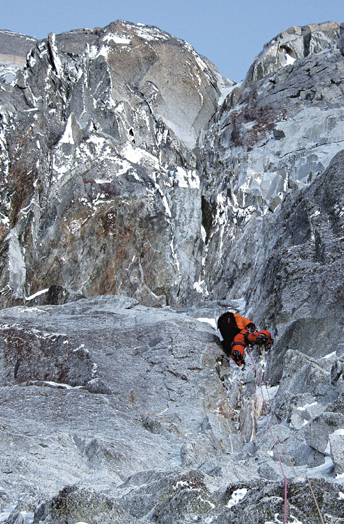On March 15, Christophe Dumarest and I set off to link three north faces
on three of the most beautiful mountains in the Mont Blanc Massif: the
Aiguille Sans Nom (3982m) via the Gabarrou-Silvy (VI WI6 6b A1, 1000m,
Gabarrou-Silvy, 1978); the Grandes Jorasses (4208m) via the
Gabarrou-Appertet (ED: 850m, Appertet-Gabarrou, 1992) on the Pointe
Marguerite; and Mont Blanc (4810m) via the Gabarrou-Long (MD sup: V+,
750m, Gabarrou-Long, 1983) on the Grand Pilier d’Angle. My good climbing
partner Patrick Gabarrou had opened all three of these direct and
difficult routes; two of them–the Gabarrou-Appertet and the
Gabarrou-Long–remained unrepeated.

Aymeric Clouet on a winter ascent of the Gabarrou-Silvy (VI WI6 6c M9 A1, 1000m, Gabarrou-Silvy, 1978) on the Aiguille Sans Nom (3982m). Clouet and Christophe Dumarest climbed the route in two days in March. Two days after descending, they began the first winter ascent (second overall) of the Gabarrou-Appertet (ED: 850m, Appertet-Gabarrou, 1992) on the Grandes Jorasses? Pointe Margerite (4066m). [Photo] Christophe Dumarest
The first 350 meters of the Gabarrou-Silvy were the most difficult: 6c
M9 at 3500 meters. At dark we had to bivy on a snow ledge in the middle
of the face (-20 degrees C if we’d been sheltered from the wind, which we
weren’t). At sunrise we started climbing a 300-meter black ice slope,
followed by a dessicated and at times overhanging couloir.
The route exited onto a ridge covered in ice on the north side and snow
on the south. Our lack of acclimatisation coupled with the poor
conditions made us suffer. Night fell as we descended the Whymper
Couloir. At the bottom we dug a hole for shelter and melted some snow.
By daybreak we made it to the Couvercle Refuge, then continued to the
Leschaux Refuge the next day. Our friends carried our equipment to help
us recuperate.
Two days later, on March 19, we left for the north face of the Grandes
Jorasses. After eight hours of climbing on the initial 500 meters (the
upper slabs of which were verglassed), we bivied at the foot of the
Pointe Marguerite. Clouds started to close in, and snow dusted the rock
face. We had to sweep each meter–and to aid most of it with our small
rack. At 6 p.m. we finally reached the beginning of the crux: a
fifty-meter, overhanging dihedral that shot up diagonally to the left.
We bivied again without tents, ten meters from each other, melting a
liter of snow and swallowing some dried Chinese noodles for dinner.
At 5 a.m. it continued to snow, and it took nearly two hours to melt two
liters. Just as we expected, the dihedral was difficult. We had only
three blades and a microcam, and I had to backclean each of the pitons
to reuse them. Conquering this technical and, at times, dangerous
section demanded more than four hours. Christophe then took the overhang
and climbed the final and most challenging part of the face.
At 6 p.m., when we reached the top of the Pointe Marguerite, the snow
became a blizzard. The climb down from the Jorasses started with two
abseils, followed by a risky traverse across the gap to the Pointe
Young. As it grew dark, the batteries in Christophe’s headlamp died. At
the moment we roped together, the snow gave way beneath Christophe’s
feet and he fell toward Italy. The rope held, but we decided to call it
a day.
At 4 a.m. on March 22, we reached the Canzio Refuge in a storm. We
caught a few hours of sleep, then, because the weather was not predicted
to improve, we went to the Leschaux Refuge. We still hadn’t climbed the
third north face, Mont Blanc’s Grand Pilier d’Angle, but we had the
beginnings of frostbite and the forecast was no better. In the
mountaineering world, the meglomaniac is doomed to fail. So on March 24,
we descended. It had taken us eight days to climb the north faces of the
Aiguille Verte and the Grandes Jorasses, and we had made the first
winter ascent (second overall) of the Gabarrou-Appertet. The harsh
snowstorm had solidified our friendship and trust. But most important,
we had both known when to stop.
–Aymeric Clouet, Samoens, France